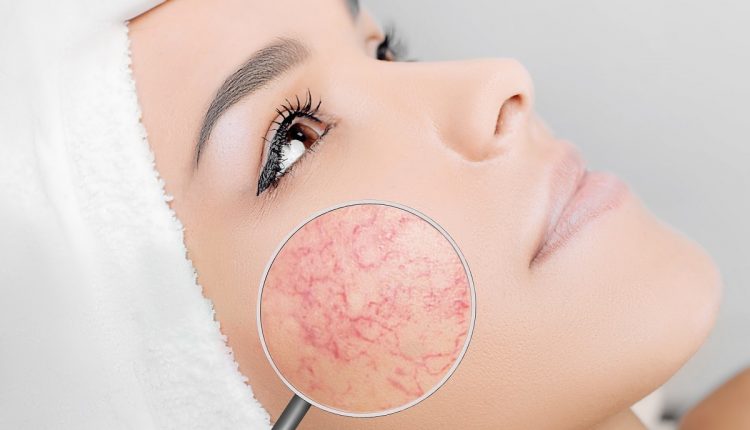
Couperose: ມັນແມ່ນຫຍັງ?
Couperose is a form of chronic dermatitis of a benign nature that predominantly affects the face resulting in a ‘red cheek’ appearance
In addition to the cheeks, the nose, forehead, cheekbones and sometimes the sternal region may be affected.
ອາການຕ່າງໆແມ່ນຫຍັງ?
Couperose presents with the appearance of redness, warm skin and evidence of small dilated blood capillaries on the wings of the nose (sides of the nose), cheeks, cheekbones and forehead.
Subjects may complain of a burning sensation or intense heat; some of them also report the appearance of these symptoms at the same locations during sudden temperature changes or intense emotions.
ເຫດຜົນແມ່ນຫຍັງ?
To date, the causes of this dermatitis are not entirely clear.
A certain familial predisposition to its development has been identified, aggravated by other factors including stress, exposure to the sun, sudden changes in temperature, vitamin deficiencies and excessive consumption of stimulating foods and spices.
Hormones may also play a significant role, with women being the most affected by this disorder.
Taking oral contraceptives or the pre-menopausal period are associated with the appearance of rosacea.
Finally, both oral and topical cortisone therapies are among the risk factors.
How is it diagnosed and which doctor to contact?
Diagnosis is made by a simple objective test by the doctor.
The specialist to whom one should refer specifically is the dermatologist, to whom it would be advisable to present oneself cleansed and with cleansed face for an appropriate evaluation.
Couperose: possible complications
Fortunately, rosacea is not a serious condition and in most cases is not associated with major consequences for the sufferer.
In some patients, however, rosacea is the phase preceding the appearance of acne rosacea, which is characterised by the presence of papular-pustular lesions and telangiectasias on the cheeks, forehead and nose.
In some cases, rosacea has an ocular involvement associated with symptoms such as redness, dry eyes, itching, swelling of the eyelids, increased sensitivity to light and accentuated tearing.
Couperose: can it be prevented?
A number of precautions can be taken for sufferers of this disorder:
- Adequate diet, avoiding exciting substances.
- Cleansing the skin with gentle products and paying particular attention to the use of aggressive cosmetics.
- Avoid tanning lamps or exposure to excessively hot (e.g. saunas) or cold temperatures.
Couperose: what are the treatments?
As already mentioned, couperose is in most cases a cosmetic problem.
In cases where it is particularly disabling for the sufferer from a psychological point of view, soothing creams can be used.
However, there are no cure-all treatments and unfortunately, once it has appeared, rosacea cannot be eliminated 100%.
In some cases, laser or diathermocoagulation can be used.
Are there natural remedies for rosacea?
You can use compresses or natural creams based on chamomile, which soothe the affected area and flush it out.
Remedies based on mallow, calendula and liquorice are also excellent, as are creams containing active ingredients from plants such as bilberry, centella asiatica, butcher’s broom and horse chestnut.
ການປິ່ນປົວເຄື່ອງສໍາອາງ
Although they cannot play a therapeutic role as they are cosmetics and not drugs, cosmetics used for rosacea can contain ingredients that can have a soothing and redness-reducing activity, or protect against UV radiation.
ອ່ານຍັງໄດ້
ມີຊີວິດສຸກເສີນຫຼາຍຂຶ້ນ…ສົດ: ດາວໂຫລດແອັບຟຣີໃໝ່ຂອງໜັງສືພິມຂອງເຈົ້າສຳລັບ IOS ແລະ Android
ວິທີແກ້ໄຂແລະສາເຫດຂອງ couperose ເທິງໃບຫນ້າ
ວິທີການຮັບຮູ້ແລະປິ່ນປົວ Melanoma
Moles: ຮູ້ຈັກພວກມັນເພື່ອຮັບຮູ້ Melanoma
Melanoma ຜິວຫນັງ: ປະເພດ, ອາການ, ການບົ່ງມະຕິແລະການປິ່ນປົວຫລ້າສຸດ
Melanoma: ການປ້ອງກັນ ແລະການກວດຜິວໜັງແມ່ນມີຄວາມຈຳເປັນຕໍ່ກັບມະເຮັງຜິວໜັງ
ຕິດຕໍ່ພະຍາດຜິວໜັງ: ການປິ່ນປົວຄົນເຈັບ
ໂຣກຜິວໜັງ: ປະເພດຕ່າງໆແລະວິທີການ ຈຳ ແນກພວກມັນ
ພະຍາດຜິວໜັງແລະອາການຄັນໃນເວລາຖືພາ: ເວລາໃດມັນເປັນປົກກະຕິແລະເວລາທີ່ຕ້ອງກັງວົນ?
ພະຍາດຜິວໜັງ Stress: ສາເຫດ, ອາການແລະວິທີແກ້ໄຂ
Cellulitis ຕິດເຊື້ອ: ມັນແມ່ນຫຍັງ? ການວິນິດໄສ ແລະການປິ່ນປົວ
ພະຍາດຜິວໜັງຕິດຕໍ່: ສາເຫດແລະອາການ
ພະຍາດຜິວຫນັງ: ວິທີການປິ່ນປົວ psoriasis?
Pityriasis Alba: ມັນແມ່ນຫຍັງ, ມັນສະແດງຕົວຂອງມັນເອງແນວໃດແລະການປິ່ນປົວແມ່ນຫຍັງ
Atopic dermatitis: ການປິ່ນປົວແລະການປິ່ນປົວ
Psoriasis, ເປັນພະຍາດທີ່ມີຜົນກະທົບຕໍ່ຈິດໃຈເຊັ່ນດຽວກັນກັບຜິວຫນັງ
ພະຍາດຜິວໜັງຕິດຕໍ່ທີ່ມີອາການແພ້ ແລະ ຜິວໜັງ Atopic: ຄວາມແຕກຕ່າງ
ປະຕິກິລິຍາທາງລົບຂອງຢາເສບຕິດ: ພວກມັນແມ່ນຫຍັງແລະວິທີການຈັດການຜົນກະທົບທາງລົບ
ອາການແລະວິທີແກ້ໄຂຂອງອາການແພ້ Rhinitis
ອາການແພ້ Conjunctivitis: ສາເຫດ, ອາການແລະການປ້ອງກັນ
ແມ່ນຫຍັງແລະວິທີການອ່ານການທົດສອບພູມແພ້
Eczema ຫຼືໂຣກຜິວໜັງເຢັນ: ນີ້ແມ່ນສິ່ງທີ່ຕ້ອງເຮັດ
Psoriasis, ພະຍາດຜິວຫນັງທີ່ບໍ່ມີອາຍຸ
ອາການທາງຄລີນິກຂອງພະຍາດຜິວໜັງ Atopic
Dermatomyositis: ມັນແມ່ນຫຍັງແລະວິທີການປິ່ນປົວມັນ
Atopic dermatitis: ອາການແລະການວິນິດໄສ



